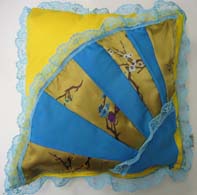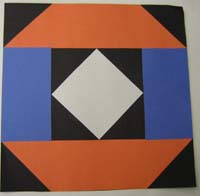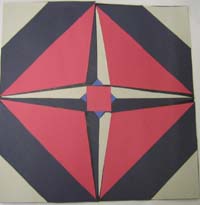 I have always had an interest in sewing or needlework of some kind since I was 6 years old and in Girl Scouts where I first learned how to embroider. I've always had a love of quilts and after my mom's passing and I found an old quilt top she had that her aunt had appliquéd but never quilted I decided it was time to learn. As I was going through some boxes of material looking for some to use in a quilt, I found the twenty quilt squares that I had traded with other Girl Scout/Girl Guide leaders from across the United States and Canada.
I have always had an interest in sewing or needlework of some kind since I was 6 years old and in Girl Scouts where I first learned how to embroider. I've always had a love of quilts and after my mom's passing and I found an old quilt top she had that her aunt had appliquéd but never quilted I decided it was time to learn. As I was going through some boxes of material looking for some to use in a quilt, I found the twenty quilt squares that I had traded with other Girl Scout/Girl Guide leaders from across the United States and Canada.
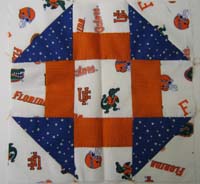 So for my first quilt I pieced those squares together and with help from a lady in my church hand quilted my first quilt. Then I took a quilt class and made my second quilt, this time all by machine. The love of quilting began, my children made requests for quilts and it was in the piecing of my son's quilt top that I really began to see the math in quilting. All the angles, laying the material perpendicular to sew and all the shapes-geometric shapes involved in the quilts. From this and my love of math, I thought of having students make quilt blocks out of geometric shapes.
So for my first quilt I pieced those squares together and with help from a lady in my church hand quilted my first quilt. Then I took a quilt class and made my second quilt, this time all by machine. The love of quilting began, my children made requests for quilts and it was in the piecing of my son's quilt top that I really began to see the math in quilting. All the angles, laying the material perpendicular to sew and all the shapes-geometric shapes involved in the quilts. From this and my love of math, I thought of having students make quilt blocks out of geometric shapes.
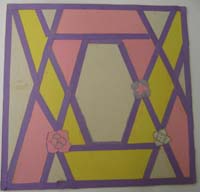 During the spring semester after studying polygons, parallel and perpendicular lines, I assigned a project to my geometry classes to either research a quilt pattern or to design a pattern of their own that incorporates three different geometric shapes. The students were given some websites that they could utilize in their research of quilting and were required to do an essay on the history of quilting, including information about their chosen quilt design.
During the spring semester after studying polygons, parallel and perpendicular lines, I assigned a project to my geometry classes to either research a quilt pattern or to design a pattern of their own that incorporates three different geometric shapes. The students were given some websites that they could utilize in their research of quilting and were required to do an essay on the history of quilting, including information about their chosen quilt design.
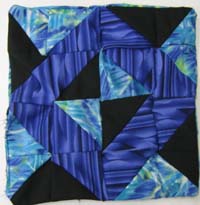 If the students designed their own then they had to include information about how they came up with the design and colors in their essay. The essay had to include information about the history of quilting, the history of their quilt block including names of variations of their block or information on their choice of design(s) and colors if they designed their own block.
If the students designed their own then they had to include information about how they came up with the design and colors in their essay. The essay had to include information about the history of quilting, the history of their quilt block including names of variations of their block or information on their choice of design(s) and colors if they designed their own block.
 The quilt blocks were to be 12 X 12 blocks and could be made either of fabric or paper. As an aide to the students, they were asked to go to the Colored Triangle Page website and "create" a quilt pattern using the colored triangles. This quilt pattern they created did not have to be their final pattern. It was my idea that this page would help them visualize how they could put together colors and shapes to create a design.
The quilt blocks were to be 12 X 12 blocks and could be made either of fabric or paper. As an aide to the students, they were asked to go to the Colored Triangle Page website and "create" a quilt pattern using the colored triangles. This quilt pattern they created did not have to be their final pattern. It was my idea that this page would help them visualize how they could put together colors and shapes to create a design.
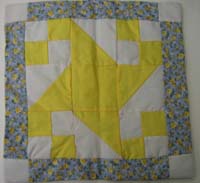 Also, they could use two or more triangles of the same color to create a different shape (i.e. two triangles could form a rectangle or square). Students could combine two "overlapping" shapes to form a different shape (for example: putting a triangle together with a square to form a trapezoid, etc.). I brought in examples of quilts that I had made for students to get ideas of overlapping figures, use of color, and by combining several blocks how a quilt is formed.
Also, they could use two or more triangles of the same color to create a different shape (i.e. two triangles could form a rectangle or square). Students could combine two "overlapping" shapes to form a different shape (for example: putting a triangle together with a square to form a trapezoid, etc.). I brought in examples of quilts that I had made for students to get ideas of overlapping figures, use of color, and by combining several blocks how a quilt is formed.
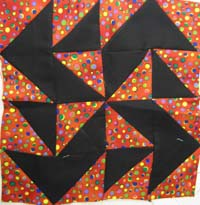 The students were asked to draw a pattern of their quilt block using graph paper. They used large graph paper consisting of one inch squares to assist them in making their pattern for the final block. Each student presented their blocks and gave a brief overview of their block design and history or information. Included in their portfolios was an evaluation of the project.
The students were asked to draw a pattern of their quilt block using graph paper. They used large graph paper consisting of one inch squares to assist them in making their pattern for the final block. Each student presented their blocks and gave a brief overview of their block design and history or information. Included in their portfolios was an evaluation of the project.
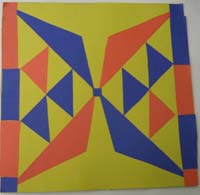 Several students decided to make their squares out of fabric, as it turned out I had a few students who already knew how to sew. One student even made a pillow out of her quilt block. Many of the students stated that they enjoyed the project much more than they originally thought, that is was a challenge, and that they learned that quilting is not just about being able to sew, but were surprised at the math that is actually involved.
Several students decided to make their squares out of fabric, as it turned out I had a few students who already knew how to sew. One student even made a pillow out of her quilt block. Many of the students stated that they enjoyed the project much more than they originally thought, that is was a challenge, and that they learned that quilting is not just about being able to sew, but were surprised at the math that is actually involved.
(Do not reproduce any material from this site without permission.)
were designed by Donna Tuttle's students.

